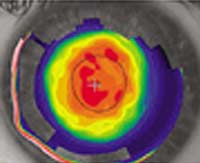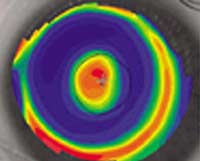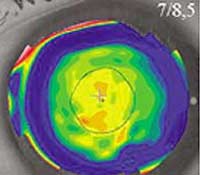LASIK, LASEK comparable in hyperopic treatment
Early stability of results in LASIK is counterbalanced by a greater possibility of enlarging optical zones in LASEK.
ROME – LASIK and laser epithelial keratomileusis are equally viable options in hyperopic treatment, and their advantages and disadvantages are more or less balanced, according to one surgeon.
“The true advantage of LASIK is that recovery is faster and visual results are stable at a very early stage after surgery. On the other hand, LASEK offers an almost unlimited possibility of enlarging the optical zone and therefore customizing the ablation,” said Ugo Cimberle, MD, of Ravenna, here at Rome 2002.
He said a critical point of the hyperopic treatment is that of increasing the curvature of the cornea but distributing the ablation on a large surface, creating smooth gradual transition zones between the periphery and the optical zone and between the optical zone and the center of the cornea.
“Regression, one of the main problems with PRK, is caused by epithelial and stromal tissue trying to fill in the gap between treated and untreated cornea. So, either you keep that gap as shallow as possible, or you perform it so far in the periphery that scarring phenomena take place outside the optical zone,” Dr. Cimberle said.
Large optical zones are always the best option, he said, because the transition zone is in the periphery and, although steep, will not affect the central area in case of regression. Small optical zones, although transitions may be smooth and gradual, are always at risk of being affected by tissue lamination.
Centration is another crucial issue in hyperopic correction.
“Hyperopic ablation is steep, with big changes of the curvature gradient in a small space. If it’s not well centered, optical aberrations and, consequently, diffractive phenomena are produced, especially in eyes with large pupils,” he said.
Pros and cons
For these reasons, photorefractive keratectomy often produced poor results in hyperopic eyes, Dr. Cimberle said. Regression, haze, induced astigmatism and irregular optical zone surfaces were frequent.
“Both LASIK and LASEK have helped us to overcome most of these problems,” he said.
He added that LASIK, especially with the new lasers, can create fairly large optical zones, with transitions in the distant periphery and smooth, regular surfaces. The flap has a further smoothing effect on the optical surface, which can compensate for sometimes-imperfect ablations and produce a good final visual result. Further advantages are fast recovery, absence of pain and the possibility of short-term re-treatment.
“On the other hand, there are surgical risks in LASIK, like a poor centration of the cut and imperfect adhesion of the flap, which may lead to the formation of microfolds and striae,” he said.
The main disadvantage, he noted, is the limits that the flap imposes on the size of the optical zone, especially in the hinge area. This reduces the range of correction of hyperopic LASIK and makes the technique unsuitable for customized ablation. Small eyes, like hyperopic eyes, are often poor candidates for LASIK anyway, he added.
LASEK is easier to perform than LASIK, and has reduced surgical risks, Dr. Cimberle said.
“The main advantage of this technique is that there are almost no limits to the size of optical zone. Disepithelialization allows us to go as far as we want, and this is a very favorable condition for custom ablation. We can sometimes go beyond the limits of 48 D using a large optical zone and a fairly low gradient of curvature, and consequently obtain very good visual results,” he said.
Disadvantages, compared to LASIK, are slower visual recovery and the presence of some postoperative pain, which might not be as severe as in PRK, but is experienced by some patients.
Comparable results
Dr. Cimberle currently uses both techniques for hyperopic treatment, and in both he performs the ablation with the Schwind Esiris laser. Long-term results are comparable, he said.
“Predictability is about the same in LASIK and LASEK, and the spherical equivalent at 3 months is very similar. There are more variations with LASEK in the first postoperative period, then results become stable, and are comparable to LASIK results,” he said.
Best corrected visual acuity safety at 3 months is very similar with the two techniques, with a slight advantage to LASEK in the long term.
Haze is a rare event in both LASIK and LASEK, with a significant difference compared to PRK.
In conclusion, both techniques are suitable for hyperopic treatment, according to Dr. Cimberle.
“The choice should be made for each individual case, particularly in relation to the amount of correction needed, and according to the surgeon’s experience and to the type of laser available,” he said.
|
|
|
|
|
|
For Your Information:
- Ugo Cimberle, MD, can be contacted at CIDIEMME, Centro di Microchirurgia Oculare, Via Berlinguer 14, Ravenna, Italy; (39) 054-440-4355; fax: (39) 054-440-8956; e-mail: info@cidiemme.it; private e-mail: cimberle@tin.it.
- Rome 2002, the 7th Annual Rome Symposium on Cataract, Refractive and Glaucoma Surgery, was sponsored jointly by Ocular Surgery News, the International Society of Refractive Surgery and the Italian Association of Cataract and Refractive Surgery.





